springboot接受参数相关注解
1.基本介绍

2.@pathvariable 路径参数获取信息
1.代码实例
1.index.html
<!doctype html>
<html lang="en">
<head>
<meta charset="utf-8">
<title>title</title>
</head>
<body>
<h1>基本注解</h1>
<hr/>
<a href="/monster/100/king" rel="external nofollow" >@pathvariable-路径变量:/monster/100/king</a>
</body>
</html>2.parametercontroller.java
package com.sun.springboot.controller;
import org.springframework.web.bind.annotation.getmapping;
import org.springframework.web.bind.annotation.pathvariable;
import org.springframework.web.bind.annotation.restcontroller;
import java.util.map;
/**
* @author 孙显圣
* @version 1.0
*/
@restcontroller
public class parametercontroller {
@getmapping("/monster/{id}/{name}") //接受两个路径参数
public string pathvariable(@pathvariable("id") integer id, @pathvariable("name") string name,
@pathvariable map<string, string> map) { //这里的map指将所有的路径参数都放到map中
system.out.println("id:" + id + " name:" + name);
for (map.entry<string, string> entry : map.entryset()) {
system.out.println("key:" + entry.getkey() + " value: " + entry.getvalue());
}
return "success"; //返回json给浏览器
}
}
3.测试
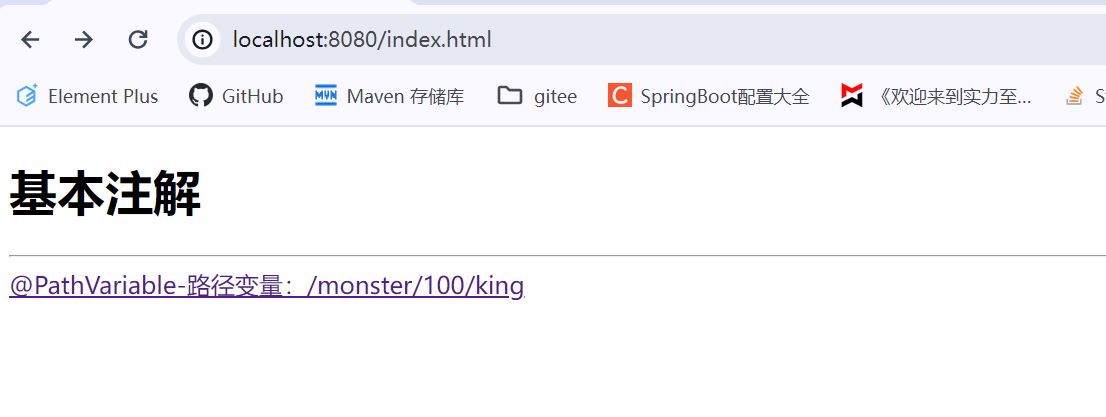

2.细节说明
- @pathvariable(“xxx”)必须跟{xxx}相对应
- 可以将所有的路径参数放到map中 @pathvariable map<string, string> map
3.@requestheader 请求头获取信息
1.代码实例
1.index.html
<!doctype html>
<html lang="en">
<head>
<meta charset="utf-8">
<title>title</title>
</head>
<body>
<h1>基本注解</h1>
<hr/>
<a href="/requestheader" rel="external nofollow" >@requestheader-获取请求头信息</a>
</body>
</html>2.parametercontroller.java
package com.sun.springboot.controller;
import org.springframework.web.bind.annotation.getmapping;
import org.springframework.web.bind.annotation.requestheader;
import org.springframework.web.bind.annotation.restcontroller;
import java.util.map;
/**
* @author 孙显圣
* @version 1.0
*/
@restcontroller
public class parametercontroller {
@getmapping("/requestheader") //获取请求头的信息
public string requestheader(@requestheader("host") string host, @requestheader map<string, string> header) {
system.out.println("host:" + host);
system.out.println(header);
return "success";
}
}
3.测试
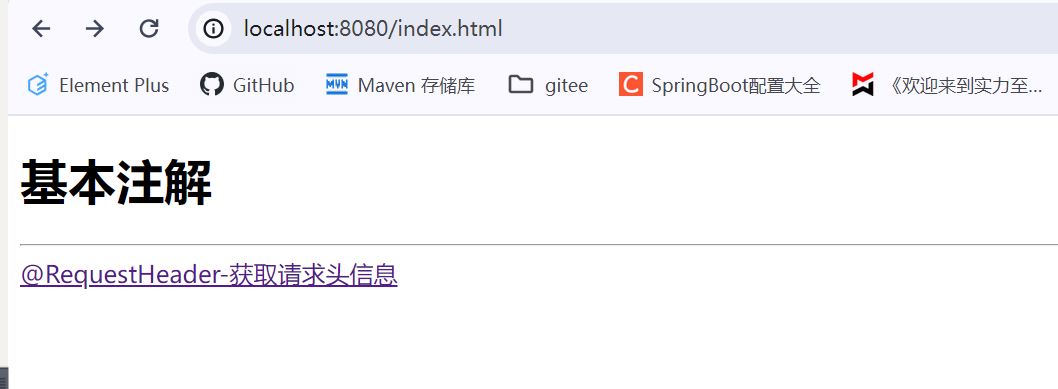

2.细节说明
- 请求头的信息都是以key - value的形式存储的
- 可以通过@requestheader(“xxx”)来获取xxx对应的value
- 也可以通过@requestheader map<string, string> header将所有的key - value都封装到map中
4.@requestparameter 请求获取参数信息
1.代码实例
1.index.html
<!doctype html>
<html lang="en">
<head>
<meta charset="utf-8">
<title>title</title>
</head>
<body>
<h1>基本注解</h1>
<hr/>
<a href="/hi?hobby=打篮球&hobby=踢球" rel="external nofollow" >@requestparam-请求参数</a>
</body>
</html>2.parametercontroller.java
package com.sun.springboot.controller;
import org.springframework.web.bind.annotation.*;
import java.util.list;
/**
* @author 孙显圣
* @version 1.0
*/
@restcontroller
public class parametercontroller {
@getmapping("/hi")
public string hi(@requestparam(value = "name", defaultvalue = "孙显圣") string name,
@requestparam("hobby") list<string> list) {
system.out.println("name:" + name);
system.out.println(list);
return "success";
}
}
3.测试


2.细节说明
- 请求参数是可以设置默认值的,使用defaultvalue属性即可
- 请求参数还可以将同名的结果封装到list中
- 请求参数也可以使用@requestparameter map<string, string> map 将所有参数封装到map中,但是如果有同名的结果只会得到第一个,因为map的key是唯一的
5.@cookievalue cookie获取值
1.代码实例
1.index.html
<!doctype html>
<html lang="en">
<head>
<meta charset="utf-8">
<title>title</title>
</head>
<body>
<h1>基本注解</h1>
<hr/>
<a href="/cookie" rel="external nofollow" >@cookievalue-获取cookie的值</a>
</body>
</html>2.parametercontroller.java
package com.sun.springboot.controller;
import org.springframework.web.bind.annotation.*;
import javax.servlet.http.cookie;
import javax.servlet.http.httpservletrequest;
/**
* @author 孙显圣
* @version 1.0
*/
@restcontroller
public class parametercontroller {
@getmapping("/cookie")
//这里可以设置required = false意为不是必须存在的,如果不存在则得到的值就为null
//如果后面的参数类型是cookie,则会获取cookie对象并封装到变量中
public string cookie(@cookievalue(value = "cookie_key", required = false) string cookie_value,
@cookievalue(value = "username" , required = false) cookie cookie, httpservletrequest request) {
//使用原生api获取cookies
cookie[] cookies = request.getcookies();
for (cookie cookie1 : cookies) {
system.out.println(cookie1);
}
system.out.println(cookie_value);
system.out.println("name:" + cookie.getname() + " value: " + cookie.getvalue());
return "success";
}
}3.测试

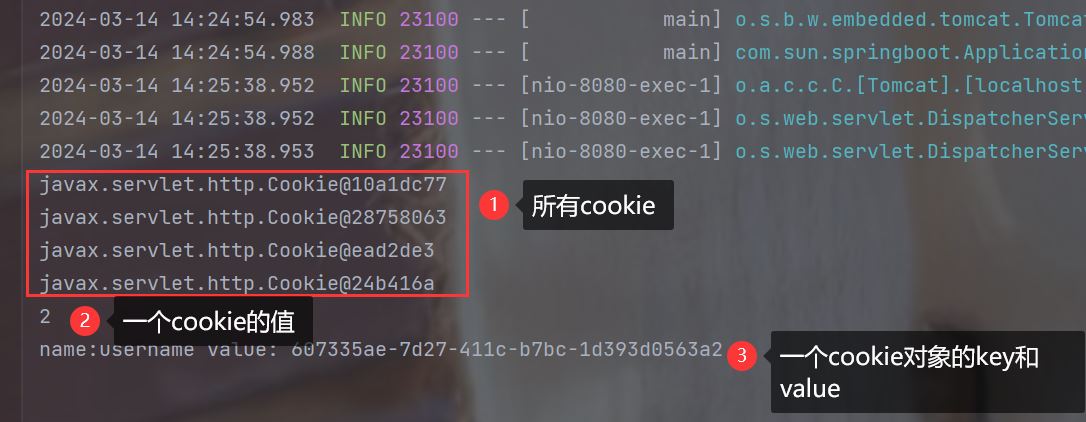
2.细节说明
- @cookievalue可以根据后面要封装的参数的类型来获取指定的值,如果后面的类型是cookie类型则会获取一个cookie对象并封装进入,如果是string类型则会获取cookie的value来进行封装
- 还可以通过servlet原生api的request来获取所有的cookie
- @cookievalue中有属性required默认为true,意为必须存在,否则报错,如果设置为false,则如果获取不到则为null
6.@requestbody 处理json请求,post请求体获取信息
1.代码实例
1.index.html
<!doctype html>
<html lang="en">
<head>
<meta charset="utf-8">
<title>title</title>
</head>
<body>
<h1>基本注解</h1>
<hr/>
<form action="/requestbody" method="post">
<input type="text" name="username"><br>
<input type="text" name="password"><br>
<input type="submit" value="submit">
</form>
</body>
</html>2.parametercontroller.java
package com.sun.springboot.controller;
import org.springframework.web.bind.annotation.*;
/**
* @author 孙显圣
* @version 1.0
*/
@restcontroller
public class parametercontroller {
@postmapping("requestbody")
public string getrequestbody(@requestbody string requestbody) { //获取请求体
system.out.println(requestbody);
return "success";
}
}
3.测试
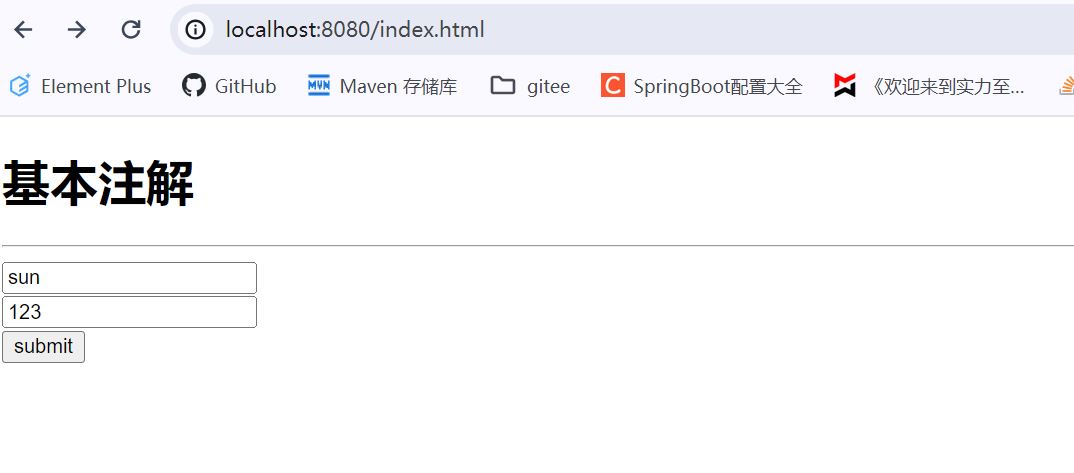

7.@requestattribute 请求域获取信息
1.代码实例
1.requestcontroller.java
package com.sun.springboot.controller;
import org.springframework.stereotype.controller;
import org.springframework.web.bind.annotation.getmapping;
import org.springframework.web.bind.annotation.requestattribute;
import org.springframework.web.bind.annotation.responsebody;
import javax.servlet.http.httpservletrequest;
/**
* @author 孙显圣
* @version 1.0
*/
@controller
public class requestcontroller {
@getmapping("/login")
public string login(httpservletrequest request) {
//在request域中存放一些信息
request.setattribute("name", "sun");
request.setattribute("age", 13);
//调用视图解析器,请求转发到/ok
return "forward:/ok";
}
@responsebody
@getmapping("/ok")
public string ok(@requestattribute(value = "name", required = false) string name) { //使用注解来获取请求域中的信息并封装到参数中
system.out.println("name: " + name);
return "success"; //返回json给浏览器
}
}
2.配置视图解析器 application.yml
spring:
mvc:
view: #配置了视图解析器
suffix: .html #后缀
prefix: / #前缀,指的是根目录
3.测试


8.@sessionattribute session域获取信息
1.代码实例
1.sessioncontroller.java
package com.sun.springboot.controller;
import org.springframework.stereotype.controller;
import org.springframework.web.bind.annotation.getmapping;
import org.springframework.web.bind.annotation.responsebody;
import org.springframework.web.bind.annotation.sessionattribute;
import javax.servlet.http.httpservletrequest;
/**
* @author 孙显圣
* @version 1.0
*/
@controller
public class sessioncontroller {
@getmapping("/login")
public string login(httpservletrequest request) {
//在session域中设置信息
request.getsession().setattribute("session", "session_value");
//调用视图解析器,请求转发到/ok
return "forward:/ok";
}
@responsebody
@getmapping("/ok")
public string ok(@sessionattribute(value = "session") string value) { //使用注解来获取session域中的信息并封装到参数中
system.out.println("session: " + value);
return "success"; //返回json给浏览器
}
}
2.配置视图解析器(同上)
3.测试


9.复杂参数
1.代码实例
1.requestcontroller.java
package com.sun.springboot.controller;
import org.springframework.stereotype.controller;
import org.springframework.ui.model;
import org.springframework.web.bind.annotation.getmapping;
import org.springframework.web.bind.annotation.requestattribute;
import org.springframework.web.bind.annotation.responsebody;
import javax.servlet.http.httpservletresponse;
import java.util.map;
/**
* @author 孙显圣
* @version 1.0
*/
@controller
public class requestcontroller {
@getmapping("/login")
public string login(map<string, object> map, model model, httpservletresponse response) {
//给map封装信息
map.put("user", "sun");
map.put("job", "工程师");
//model封装信息
model.addattribute("sal", 1000);
//结果最后都会封装到request域中
//调用视图解析器,请求转发到/ok
return "forward:/ok";
}
@responsebody
@getmapping("/ok")
public string ok(@requestattribute("user") string user, @requestattribute("job") string job,
@requestattribute("sal") integer sal) { //使用注解来获取请求域中的信息并封装到参数中
system.out.println("user:" + user + " job:" + job + " sal:" +sal);
return "success"; //返回json给浏览器
}
}
2.测试

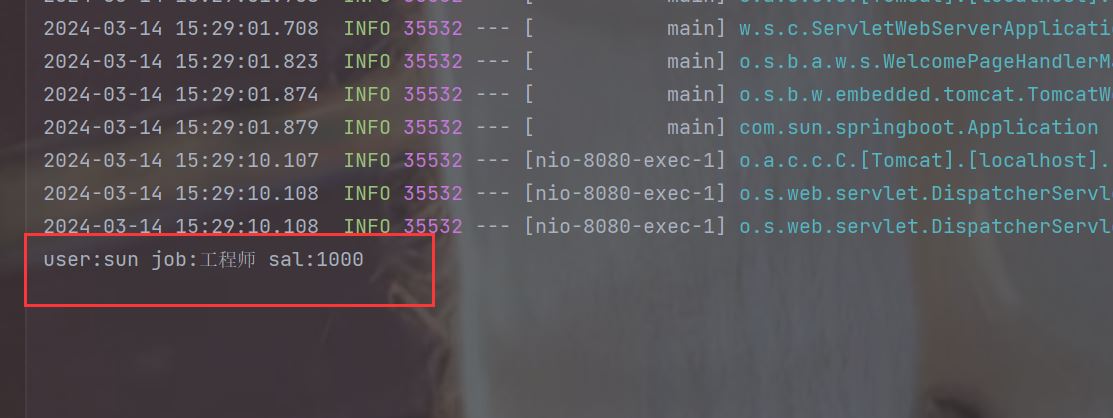
2.httpservletresponse给浏览器设置cookie
1.代码实例
package com.sun.springboot.controller;
import org.springframework.stereotype.controller;
import org.springframework.web.bind.annotation.cookievalue;
import org.springframework.web.bind.annotation.getmapping;
import org.springframework.web.bind.annotation.responsebody;
import javax.servlet.http.cookie;
import javax.servlet.http.httpservletresponse;
/**
* @author 孙显圣
* @version 1.0
*/
@controller
public class requestcontroller {
@getmapping("/login")
public string login(httpservletresponse response) {
cookie cookie = new cookie("cookie_name", "cookie_value");
response.addcookie(cookie);
//调用视图解析器,重定向到/ok,不能使用请求转发,因为虽然响应给客户端cookie了,
// 但是由于是请求转发,第二个controller得到的是最开始的请求,那时候还没有cookie
return "redirect:/ok";
}
@responsebody
@getmapping("/ok")
public string ok(@cookievalue("cookie_name") cookie cookie) {
//获取cookie
system.out.println("key:" + cookie.getname() + " value:" + cookie.getvalue());
return "success"; //返回json给浏览器
}
}2.测试


总结
以上为个人经验,希望能给大家一个参考,也希望大家多多支持代码网。



发表评论